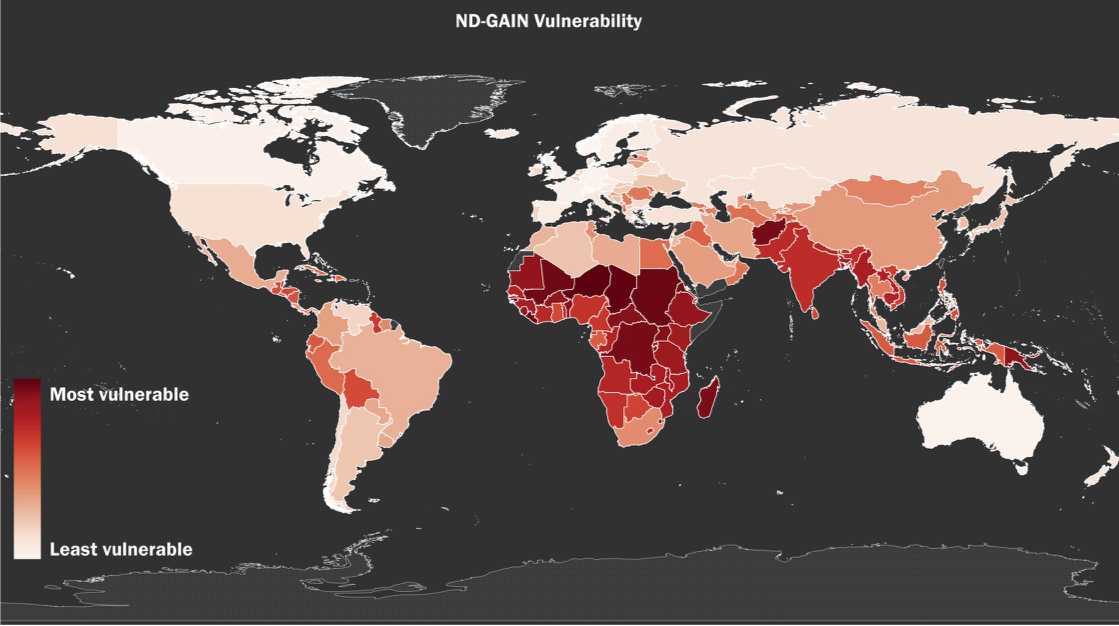- Of 176 nations considered, the top 10 found to be most vulnerable to both climate change impacts and environmental pollution are in Africa and South Asia, with the Democratic Republic of Congo being the worst off, according to a new study.
- Toxic pollution in the environment, be it dirty air, contaminated water or unhealthy soils, and climatic shifts resulting in warmer temperatures, extreme weather or land degradation, can all endanger human health.
- The study shows that tackling both kinds of risk together might be a good strategy for some countries like Singapore, Rwanda, China and India.
- It also highlighted the unequal toll of environmental destruction among nations: the 60 most vulnerable countries are home to two-thirds of the planet’s population.
With wildfires raging in the western U.S. and floods sweeping parts of Europe, it’s easy to forget that these regions are some of the most well-prepared to tackle climate change.
An analysis of 176 nations confirms what public health experts have long-suspected: the global spread of environmental pollution risks and climate risks largely mirror each other. Countries in the Global South, especially in Africa, suffer the most under this dual burden.
Eight African countries were among the 10 most vulnerable, according to the study published in the journal PLOS ONE . Of these, the Democratic Republic of Congo (DRC), Burundi and the Central African Republic are the worst off. The two other countries in the top 10 are Bangladesh and Afghanistan in South Asia.
Toxic pollution in the environment, be it dirty air, contaminated water or unhealthy soils, accounted for more than 8 million deaths globally in 2018. Chad, Madagascar, Nepal, Niger and India reported the highest proportions of total deaths linked to toxic pollution.

Climatic shifts also endanger human health in multiple ways, from dangerous temperature rise, land degradation, extreme weather events, to sea-level rise. Though harder to pin down, some estimates suggest that 250,000 excess deaths will occur every year between 2030 and 2050 because of climate change.
“These streams of pollutants have generally been looked at separately,” said Richard Marcantonio, first author of the study and a researcher at the University of Notre Dame, “even though many of their sources and many of the drivers are the same.”
The study shows that tackling both kinds of risk together might be a good strategy for some countries. It does not delve into how the hazards interact with each other.
In the real world, these two forms of environmental disturbance coincide to create life-threatening conditions. Wildfires in the U.S., which witnessed a record-breaking fire season in 2020, are testimony to the complex ways environmental phenomena endanger human life. The prolonged and intense fire season bears the imprint of a warming planet, and has also resulted in deteriorating air quality in the country.

Marcantonio and another co-author on the paper, Sean Field, have studied the relationship within the U.S., exploring how flooding redistributes toxic pollutants. But, he said, it wasn’t possible to do that for most other countries.
“The data isn’t currently granular enough for us to study the interaction between the risks, what we want to do is to get the conversation about interactive risk started,” Marcantonio, said, adding that he hoped it would also bring attention to the disparity in where risks are and who is responsible.
The authors use three key yardsticks to rank countries: “Eco-health” risk from living in a toxic environment; “Vulnerability” linked to climate change; and a third index that incorporates both of them.
The DRC tops the ranking when considering both eco-health and climate change vulnerability together. The African nation grapples with particulate matter blowing in from the Sahara Desert and also local pollution sources like inferior fuels and inefficient vehicles. The mushrooming of foreign commercial mining and artisanal mining has led to the degradation of land and water quality.
At the same time, a changing climate is expected to bring more floods and droughts, and heat waves are expected to strike frequently and stretch longer. The poor in the country are more exposed to these hazards, a World Bank report found.
The new study does not look into disparities within countries. What it does highlight is the unequal toll of environmental destruction among nations: the 60 most vulnerable countries are home to two-thirds of the planet’s population.

At a recently concluded high-level G-20 meeting, leaders failed to reach a consensus on climate goals, with deep divisions again emerging between developed and developing countries. The latter, in particular China and India, accused richer nations of ignoring their historical responsibility for greenhouse gas emissions while setting reduction targets.
What might interest decision-makers at the national and international levels is the “target” assessment provided in the paper, which shows where tackling toxic and non-toxic pollution simultaneously would be most useful.
It includes an element of readiness, which reflects how worthwhile investment in directly mitigating both risks would be. This ranking places Singapore, Rwanda, China, India and the Solomon Islands on top.
“It is not to say that the bottom 10 do not need investments in mitigating risk, but instead that there needs to be a different focus, for example, on environmental policy interventions,” Marcantonio said.
(Banner Image: Drought in Mozambique. Image Courtesy of The Australian Department of Foreign Affairs and Trade/Flickr.)
Citations:
Marcantonio, R. A., Javeline, D., Field, S., & Fuentes, A. (2021). Global distribution and coincidence of pollution, climate impacts, and health risk in the Anthropocene. PLOS ONE, 16(7), e0254060. doi:10.1371/journal.pone.0254060
Marcantonio, R. A., Field, S., & Regan, P. M. (2019). Toxic trajectories under future climate conditions. PLOS ONE, 14(12), e0226958. doi:10.1371/journal.pone.0226958












